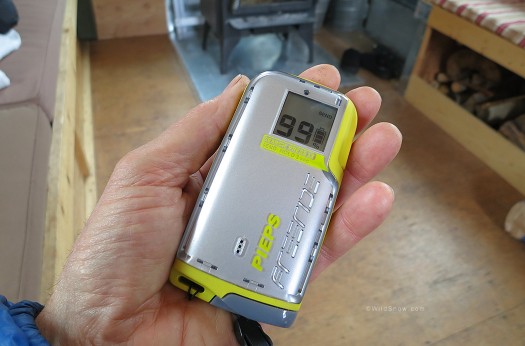
Pieps Freeride diminutive size is attractive, but limited functionality may be an issue. At 242 grams the unit is stupid light, around 120 grams (about 4 ounces, 122 grams lighter than some transceivers on the market.)
In our ever opinionated take here at Wildsnow, most avalanche rescue beacons are too big; too klunky; too heavy. Some brands are downsizing for next season, but antennas need room. Today’s amazingly effective beacons have more than one antenna, so they stay big.
Enter Pieps Freeride. In an attempt to provide a simpler, lower cost avy beacon, Freeride uses a single antenna and one AA battery. While the Freeride does process information using internal software (digital!), it harkens back to the original single antenna avy beacons of yesteryear. Barbaric tranceivers of yore had decent range and were surprisingly fast when used by a highly practiced searcher. But skip practice and you could wander to the North Pole and back trying to find your buried buddy.
Probably due to highly tweaked internal electronics, Freeride has decent signal sensitivity range (said to be less than higher-end units, but it seemed adequate to me during informal testing) and does guide you into a buried beacon by displaying an arrow on the LCD screen.
But for reasons best left for explication by the gnomes of Vienna, a single antenna beacon simply can’t provide the sensitivity or processing speed that allows you to fast-walk or even run in an arrow guided search. Instead, once you’ve got a solid pointer arrow in the Freeride LCD, you still have to slow-walk and stop frequently to let the beacon figure out where to point. What is more, once you’re within a meter or so of the buried victim’s beacon, you must revert to a grid pattern search based on visual and aural cues. Yes, you may do this with more sophisticated beacons as well, but in a somewhat smaller area than that required by the Freeride. (In other words, aggressive use of your probe may be more efficient than fiddling around with narrowing your search area using gridding.)
Bottom line: It will take you longer to find someone with Freeride than with a top-end transceiver.
How about Freeride as buried victim? That’s where this unit makes more sense. I had no trouble fast-walking a search into my Freeride tester while searching with a state-of-art unit. Thus, with its attractive price, simplicity, and easily stowed size, Freeride would perhaps make a good institutional unit that you’d hand out to folks who’d most likely never be doing a beacon search, but rather being found by their guides or other in-charge types of people. Problem is, what if the guides get buried and the clients need to find them? In that case, you’ve saddled the least competent person with the hardest to use beacon. We’ll let the guides figure that one out, but it doesn’t sound like the best situation.
At first glance, I’ll admit I thought “Wow, this would be a cool little thing to carry during low hazard days.” But on second thought, I really don’t ski that many days when avy danger is 100% zero. Instead, even low hazard days can have glitches. For example, you’re out on firm spring snowpack in the morning, planning on being home before the afternoon thaw. They you get delayed and hazard spikes from nothing to scary.
A few conclusions:
1. Since it’s affordable, Freeride would be a good spare beacon for storage in your automobile, cabin, and so forth in the event someone forgets their own unit.
2. Use in certain controlled situations could be reasonable. (e.g., a guide service with several guides and lots of clients who would never use a beacon in search mode.)
3. Ultra lightweight option for skimo racers in situations when carrying a transceiver is a formality and rule requirement, not a safety necessity.
5. But if there exists any chance at all that a person with a Pieps Freeride would have to search for a buried avalanche victim, the possible searcher should be carrying a more sophisticated unit.
5. Perhaps most worrisome is the Freeride could become quite popular with budget shoppers and gift buyers — that could be unfortunate as the units could proliferate like inexpensive socks. (Look what’s in your Christmas stocking Annie, a new beacon from dad!)
Your thoughts, WildSnowers? What will you do when someone shows up with a Freeride to tour with you?
WildSnow.com publisher emeritus and founder Lou (Louis Dawson) has a 50+ years career in climbing, backcountry skiing and ski mountaineering. He was the first person in history to ski down all 54 Colorado 14,000-foot peaks, has authored numerous books about about backcountry skiing, and has skied from the summit of Denali in Alaska, North America’s highest mountain.
